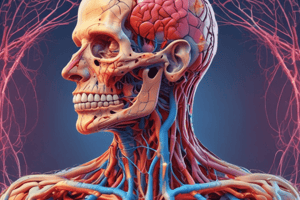Podcast
Questions and Answers
Which part of the brain is responsible for voluntary movement control?
Which part of the brain is responsible for voluntary movement control?
- Thalamus
- Cerebral Cortex (correct)
- Cerebellum
- Brainstem
What structure connects the brain with the spinal cord?
What structure connects the brain with the spinal cord?
- Medulla (correct)
- Thalamus
- Cerebellum
- Frontal lobe
Where does the spinal cord extend from and to?
Where does the spinal cord extend from and to?
- From the midbrain to the S1 vertebrae
- From the occipital lobe to the sacral region
- From the cerebrum to the lumbar region
- From the medulla to L1-L2 vertebrae (correct)
Which tract is part of the major motor pathways in the CNS?
Which tract is part of the major motor pathways in the CNS?
Which of the following structures is NOT part of the diencephalon?
Which of the following structures is NOT part of the diencephalon?
What is the primary function of the spinothalamic tract?
What is the primary function of the spinothalamic tract?
Which area is specifically associated with speech production?
Which area is specifically associated with speech production?
Which section of the spinal cord contains the largest number of nerve roots?
Which section of the spinal cord contains the largest number of nerve roots?
Flashcards are hidden until you start studying
Study Notes
Anatomy Review of the Neurologic System
- Central Nervous System (CNS) comprises the brain and spinal cord.
- Key components of the CNS include the cerebrum, diencephalon, brainstem, cerebellum, and spinal cord.
Components of the Central Nervous System
- Cerebral Cortex (Cerebrum): Responsible for higher brain functions like reasoning and voluntary movement.
- Diencephalon: Includes:
- Basal Ganglia: Involved in motor control.
- Thalamus: Acts as a relay station for sensory and motor signals.
- Hypothalamus: Regulates autonomic functions, including hunger, thirst, and body temperature.
- Brainstem: Contains:
- Midbrain: Associated with vision, hearing, and motor control.
- Pons: Connects upper and lower parts of the brain, involved in regulating sleep.
- Medulla: Controls vital functions like heart rate and respiration.
- Cerebellum: Coordinates voluntary movements and balance.
- Spinal Cord: Extends from the medulla to vertebrae L1-L2, facilitating communication between the brain and body.
Structure of the Cerebral Cortex
- Divided into:
- Frontal Lobe: Involved in thought processes, decision making, and movement.
- Parietal Lobe: Processes sensory information relating to touch, temperature, and pain.
- Occipital Lobe: Responsible for visual processing.
- Wernicke’s Area: Vital for language comprehension.
- Broca’s Area: Essential for language production.
Spinal Cord Overview
- Spinal cord is a critical conduit for motor and sensory pathways.
- Composed of five segments:
- Cervical: C1-C8
- Thoracic: T1-T12
- Lumbar: L1-5
- Sacral: S1-5
- Coccygeal: Involved in tailbone sensation.
- The cauda equina is a bundle of spinal nerves below L1-L2, resembling a horse's tail.
Major Pathways of the CNS
-
Motor Pathways:
- Corticospinal or Pyramidal Tract: Connects the brain to the spinal cord's motor neurons.
- Extrapyramidal Tracts: Involved in involuntary motor control and coordination.
- Cerebellar System: Coordinates balance and fine motor skills.
-
Sensory Pathways:
- Spinothalamic Tract: Transmits pain and temperature sensations to the brain.
- Posterior (Dorsal) Column: Handles proprioception and fine touch sensations.
Studying That Suits You
Use AI to generate personalized quizzes and flashcards to suit your learning preferences.




